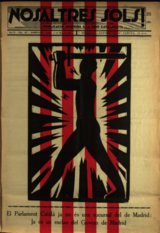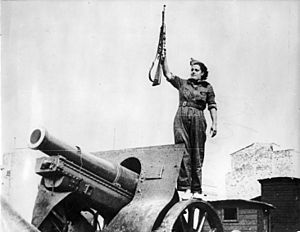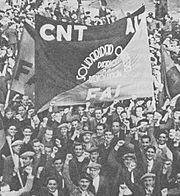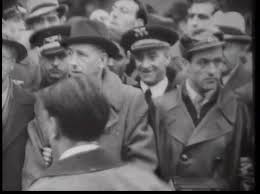1936 Catalan coup d'état attempt facts for kids
Quick facts for kids Attempted Catalan coup of 1936 |
|||||||
|---|---|---|---|---|---|---|---|
| Part of Interwar period | |||||||
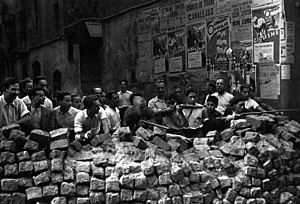 |
|||||||
|
|||||||
| Belligerents | |||||||
| Commanders and leaders | |||||||
| Lluís Companys Josep Tarradellas Dionís Eroles Artemi Aiguader Aurelio Fernández Joans Solans |
Josep Maria Xammar Joan Casanovas Andreu Revertés Manuel Blasi Joan Torres-Picart Joan Cornudella |
||||||
| Strength | |||||||
| Generalitat troops, CNT militia | EC militia and other formations | ||||||
The Catalan coup attempt was a plan to take control of Catalonia, a region in Spain that had its own government. This plan was made by the Estat Català party, which wanted Catalonia to be fully independent. The people behind the plan wanted Catalonia to stay neutral in the Spanish Civil War. They also wanted to push out other political groups, especially the Anarchists.
The plotters hoped to use their party's armed groups and some Catalan army units. They thought the main Spanish government would be too busy fighting the battle of Madrid to stop them. However, the Anarchists found out about the plan and stopped it. The government of Catalonia (called the Generalitat) arrested some of the plotters. Others escaped to France. After this, Estat Català lost its power, and the CNT-FAI (Anarchists) became very strong in Catalonia. This event is not very well-known in history.
Contents
Why the Coup Was Planned
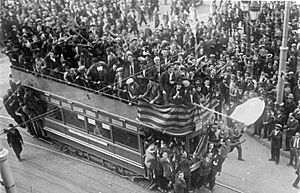
Since the late 1800s, new political ideas grew in Catalonia. Besides older groups, Socialists, Communists, Anarchists, and Catalan nationalists became popular. Anarchists were strong among city workers. Catalan nationalists gained support from middle-class people. Even though they were different, both groups wanted big changes.
In 1931, the king was removed, and the Republican Left of Catalonia (ERC) became powerful. This party, led by Francesc Macià, was a mix of nationalist groups. It controlled the Catalan parliament. Anarchists, however, did not vote. They focused on their large union, the CNT. They even tried to start a rebellion in Catalonia in late 1933.
Growing Tensions in Catalonia
In October 1934, there was a big workers' strike in Spain. Catalonia's government, led by ERC, declared a "Catalan State." But the Anarchists did not help them. Instead, they tried to set up their own worker-run communities. The Catalan government then cracked down on the Anarchists. This made the two groups dislike each other a lot.
Before the 1936 elections, Anarchists supported the Popular Front, which included ERC. But soon, their truce ended. In April, Anarchists killed Miquel Badia, who had led the crackdown on them in 1934. Many Catalan nationalists felt the government was too weak. In May 1936, Estat Català, a group that was part of ERC, left to become independent.
Who Was Estat Català?
Estat Català was a Catalan nationalist group started in the 1920s. It was different because it was very anti-government and focused on social issues. In the 1930s, it became more extreme. Its uniformed group, the Escamots, was even banned after some violent events.
Estat Català helped create ERC in the 1930s, forming its radical wing. After leaving ERC in May 1936, it became a key group for revolutionary Catalan nationalism. It soon joined with two other radical Catalan parties: Nosaltres Sols! and Partit Nacionalista Català. The main leaders of this new, combined group were Josep Dencas, Manuel Blasi, and Josep Maria Xammar. The groups were still coming together when the military coup started in Spain in July 1936.
Estat Català After the Coup
Many Estat Català members fought against the military rebels. They got many weapons during these fights. The party moved to a new office, started a newspaper called Diari de Barcelona, and recruited many people for its armed groups. Estat Català joined several groups that were trying to gain power, like the Anti-Fascist Militias Committee. However, the party did not join the main Catalan government.
Relations with the Anarchists were difficult. After the military coup failed, the Anarchists became the strongest political group in Catalonia. In August, an Anarchist group tried to raid Estat Català's main office. Anarchist leaders in the government demanded that Dencàs be arrested. He was blamed for violence against Anarchists in 1934. By September, Dencàs fled the country. Joan Torres-Picart became the new party leader.
Groups Competing for Power
In the summer of 1936, the Catalan government decided to create a Catalan army. Most parties supported this, but not the Anarchists. Estat Català was very active in forming these units. Their members led three battalions called Milícies Pirinenques (MP), which were sent to the French border. These units were made up of trained military members from Nosaltres Sols!.
In the fall, MP units began taking control of border posts in the Pyrenees mountains. They sometimes clashed with local Anarchist units who were already there. Estat Català also formed a large, 700-man battalion called Columna Volant Catalana. This group was meant to go to the Aragon front but stayed in the Lleida province. Other party armed groups were being reorganized by Joan Cornudella.
Political Discussions and Changes
By late summer 1936, Estat Català's newspapers openly called for a "Catalan revolution." They hinted that this meant declaring Catalonia's independence and removing other political groups, especially the Anarchists. Xammar spoke to Lluís Companys, the president of Catalonia, about ending the Anarchists' power. He also asked for Estat Català members to get important security jobs. Companys did not seem interested.
However, the prime minister and parliament speaker, Joan Casanovas, was more open to the idea. He had been an Estat Català member in the 1920s. He started saying publicly that the government needed to be stronger and take bold action. This was seen as a criticism of Companys's hesitant policies. This led to a conflict between Companys and Casanovas. In September, Casanovas was removed from his prime minister role. Josep Tarradellas, a close friend of Companys, took his place.
Planning the Action
Historians believe that by early October 1936, Estat Català leaders began planning a violent takeover of Catalonia. Their main strength was the armed units they controlled, including their own groups, the Columna Volant, and the MP battalions. Some were to act in Barcelona, while others would take control in other towns.
The plotters also tried to get support within local government groups. Xammar talked with officials in Northern Catalonia about working together against the Anarchists. The conspirators thought that the Catalan police would not interfere. Since early October, the head of public order, ca:Andreu Revertés, was a former Estat Català member. Even though Anarchists protested his appointment, Companys insisted on it due to a personal connection.
Seeking International Support
Estat Català representatives Josep Maria Batista i Roca and Nicolau Rubió i Serralach spoke to French and British diplomats in Spain. They asked about recognizing an independent Catalonia, but the results are not clear. They likely discussed this with representatives from Mussolini's Italy as well.
Another Estat Català member, Vicenç Borrell, traveled to Brussels to talk to Francesc Cambó, a leader of right-wing Catalan nationalists. However, Cambó was not interested. He expected the Nationalists to win the war quickly. By early November, Estat Català increased its strong independence propaganda. At many rallies, Borrell, Cornudella, Xammar, and Torres-Picart criticized the government's weak policies. Surprisingly, Casanovas attended one of these meetings. He spoke strongly about the need for bold action and criticized the Catalan parliament, which he still led. Many Estat Català armed units sent messages of support to Casanovas.
The Climax of the Plan
In early November, Nationalist troops were close to Madrid. It seemed like the Spanish Republic might fall soon. In mid-November, the Columna Volant and MP units in Catalonia were put on high alert. A strong Estat Català armed group, the Columna Germans Badia, was sent to the Madrid front. However, a group called the 2nd Milícies Pirinenques Battalion gathered in Barcelona.
A shipment of weapons and ammunition arrived from France. Revertés organized this, using government money without the knowledge of high officials. The train went to a depot in Barcelona. The distribution of hundreds of rifles and grenades to Estat Català units was discussed at a meeting on November 22. Revertés, Casanovas, Torres-Picart, Xammar, and Cornudella were there. The plan was for Estat Català groups to take over the Generalitat buildings and arrest all government members. If anyone resisted, they were to be shot. Companys, the president, would also be shot if he resisted. Casanovas would replace him as president.
The Plan Fails
On November 24, the Catalan government's security services arrested Revertés. One idea is that his subordinate, Dionisio Eroles, acted on his own. Another idea is that Eroles got permission from Tarradellas or other high officials. Eroles, an Anarchist member of the security department, had his own network of Anarchist informers. He watched Revertés and acted when he realized the coup was about to happen.
Revertés was immediately fired and questioned for hours by Eroles, his secretary Joan Solans, and the secretary of the Internal Security Council, Aurelio Fernández. It seems they made a deal: Revertés agreed to name his partners in exchange for being allowed to leave Spain. The Interior Minister, Artemi Aiguader, then ordered many arrests. Torres-Picart was arrested. Casanovas, who had special protection as a parliament member, was put under police watch.
What Happened Next
The Catalan government did not carry out a huge crackdown. Only about 100 people were arrested. Some Anarchist groups wanted to set up a quick trial for those accused of crimes against the state, but this plan was dropped. Anarchist groups raided the Diari de Barcelona offices and Estat Català headquarters.
Official news vaguely reported Revertés's dismissal, and Aiguader's public comments were very unclear. The Catalan Anarchist press strongly attacked Estat Català. Estat Català was not banned. While Torres-Picart was in jail, Cornudella declared himself the party leader. The party quickly condemned and removed any members thought to be involved in the plot. Cornudella's role is not clear; some historians think he might have worked with Eroles. The Estat Català armed groups were sent to the front lines, where they fought bravely and loyally.
Fates of the Leaders
Revertés was jailed in Montjuïc prison for a few days. He later died in unclear circumstances. One idea is he was shot in Barcelona after leaving prison. Another is that Companys's guards shot him on November 30 in Calaf, while he was on his way to Andorra. Casanovas, as a high official, was quietly allowed to leave the country. The investigation by the Court of Appeal of Catalonia was closed without any charges.
Torres-Picart managed to escape prison in unclear ways and made it to France. From there, he strongly criticized Companys. Xammar and his family crossed into France before any action was taken against him. France was also where other high Catalan officials, like Josep Maria Espanya, went. Manuel Blasi, who was leading an Estat Català armed group in Aragon, was arrested by Anarchists there. After a few weeks, he was released and left Spain by the end of 1936.
Later Lives of Key Figures
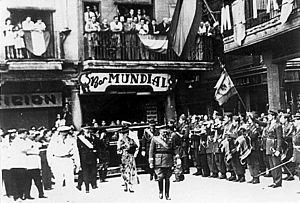
Casanovas returned to Catalonia after the May 1937 events, when Anarchist power in Catalonia was broken. He tried to arrange for Catalonia to declare neutrality, but he died in France in 1942. Espanya, Xammar, and Torres-Picart left France for Latin America, where they lived out their lives. Espanya died in 1953, Xammar in 1967, and Torres-Picart in 1988. Torres-Picart visited a democratic Spain before he died.
Cornudella and Blasi returned to Spain after 1939 and joined groups against Franco's rule. Both faced punishment. Cornudella was elected to the Catalan parliament after 1975 and died in 1985. It is not clear when Blasi died. The Estat Català groups that went into exile struggled for decades. The party was officially registered in Spain in 1977. Today, it is a small group, even though the Catalan independence movement is very strong.
The End of an Era
After the fall of Catalonia, Companys went to France. He was handed over to Franco's forces in 1940 and was executed that same year. Tarradellas lived in France and America and was the president of the exiled Catalan government for a long time. He returned to Spain in 1977 and was a well-known Catalan politician until he died in 1988.
Eroles, Aiguader, and Fernández were removed from the Catalan security forces after the 1937 Barcelona May Days. In 1939, Eroles went to France and died in unclear circumstances in 1940, possibly killed. The other two went to Mexico. Aiguader died there in 1946, and Fernández died in 1971. The fate of Solans is unknown. Catalan anarchism weakened during Franco's rule and became a small political force after 1975. Today, the CNT is a small union. Of all the people involved in the November 1936 events, only Companys and Tarradellas are widely remembered and honored in Catalonia today.
Why This Story Is Not Well Known
Except for the Anarchists, none of the groups involved wanted to talk much about the November 1936 event. So, it was quickly forgotten. It was overshadowed by the bigger power struggle in Barcelona in May 1937. Even after the war, this plot was mostly ignored. For Franco's government, it did not fit their story of a single, evil "red" group. No exiled anti-Franco groups saw it as useful for their cause either.
For historians, it has been a difficult part of Spanish history to study. The government records mostly focused on the arrests, not the plot itself. Most of Estat Català's papers are missing. Also, the stories told by the people involved often conflict, have mistakes, and show political bias.
Historians' Views
Serious studies of this event only began in the 1980s. For decades, historians did not pay much attention to it. They sometimes mentioned it briefly or gave wrong ideas about it. A detailed study of the issue was published in 2012. However, many authors are still very careful. They use words like "possibly" and say their findings are just a start.
Most scholars agree that there was a nationalist plot. But it is not clear if it was just a few Estat Català politicians or the whole party. It is also not known how far along the coup plans were or if the decision to act was truly made. Historians are not sure if the Anarchists, the Catalan government, or other groups started the counter-action. Many small questions remain unanswered, like what exactly Casanovas's role was. The Catalan coup of 1936 is often discussed when looking at broader topics, such as Catalan fascism.
Images for kids
See also
 In Spanish: Complot de noviembre de 1936 para niños
In Spanish: Complot de noviembre de 1936 para niños


